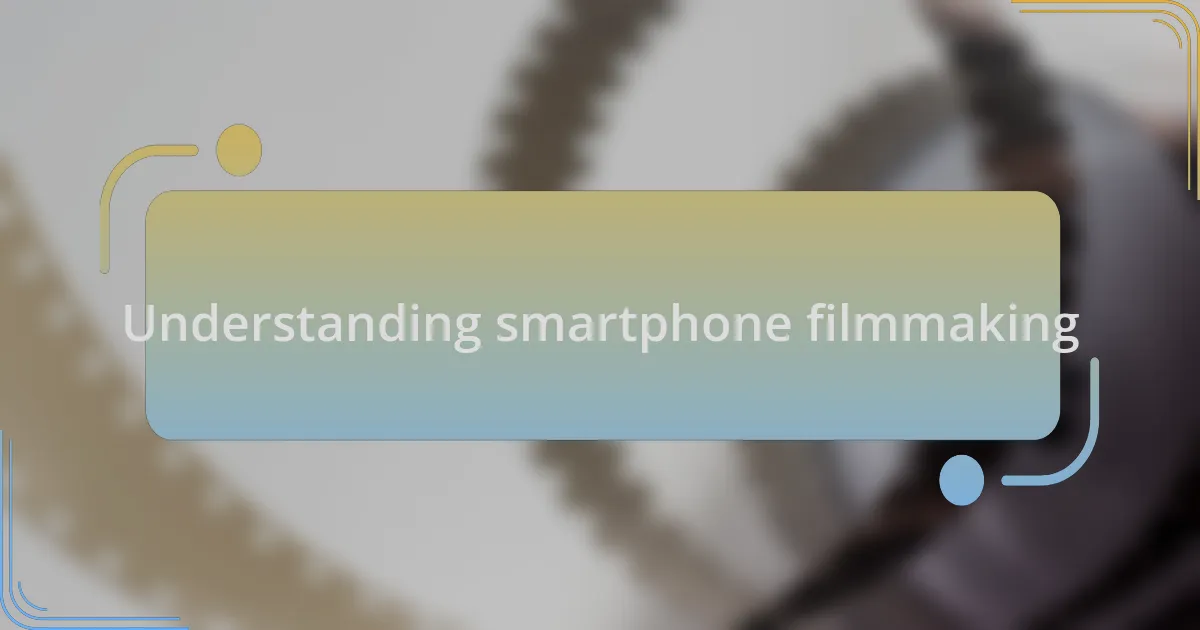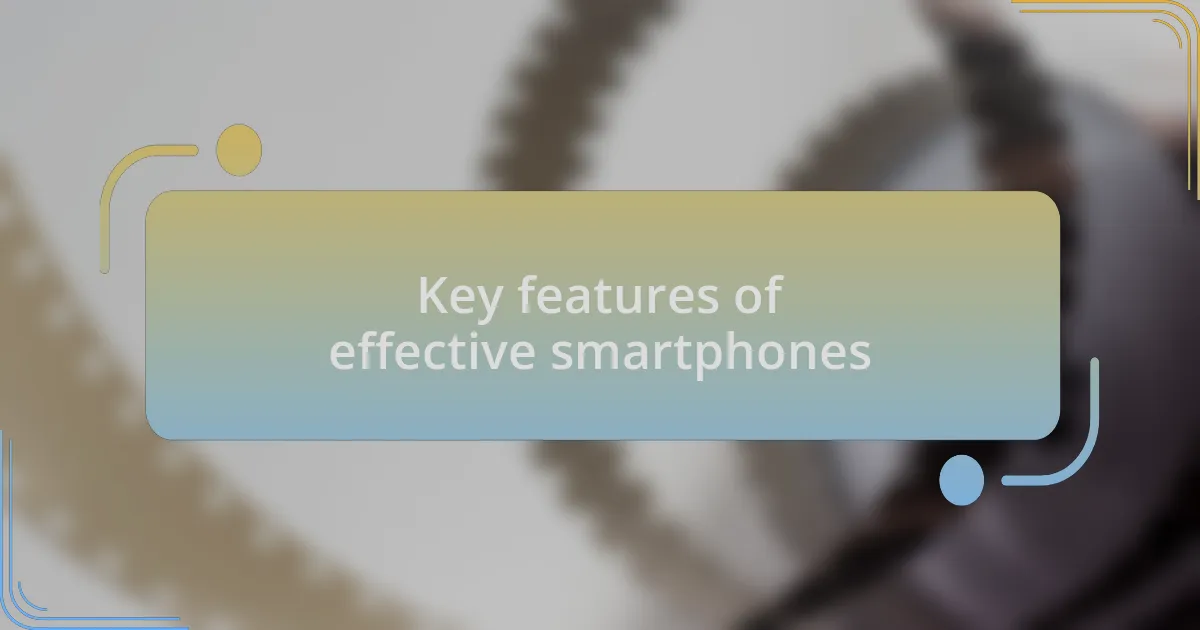Key takeaways:
- Smartphone filmmaking democratizes storytelling, enabling anyone to create and share their vision regardless of background or budget.
- Key features for effective smartphone filmmaking include high camera quality, stabilization technology, and reliable battery life.
- Essential equipment such as tripods, lighting, and external microphones can significantly enhance the quality of smartphone videos.
- Planning and editing techniques like composition, pacing, and sound design are crucial for creating polished and engaging films.

Understanding smartphone filmmaking
Smartphone filmmaking is a fascinating blend of technology and creativity that empowers anyone to tell their story. I still remember the first time I shot a short film on my phone; it felt like I had the world in my pocket. Have you ever felt the rush of capturing a spontaneous moment and realizing it could become part of a narrative?
One of the best things about smartphones is that they are always accessible. This accessibility has allowed me to film ideas whenever inspiration strikes, from my morning coffee to a sunset view. Can you imagine how many unique stories are waiting to be captured just because we have our phones handy?
While the technical aspects, such as lighting and sound, are crucial, I find that the emotional core of a film is what resonates most with viewers. It’s the raw, unscripted moments that often end up being the most powerful. Have you noticed how a simple, heartfelt scene can leave a lasting impression? Understanding this balance between technique and emotion is key to crafting compelling smartphone films.

Importance of smartphone filmmaking
The importance of smartphone filmmaking lies in its democratization of the art form. I remember attending a local film festival where I was blown away by a short film made entirely on a smartphone. It struck me how accessible filmmaking had become; anyone, regardless of budget or background, could share their vision. Have you ever thought about what new voices might emerge from this?
Another significant aspect is the quick turnaround time offered by smartphones. When I have an idea, I can shoot and edit snippets very quickly. This immediacy allows filmmakers to respond to cultural moments or personal experiences far faster than traditional methods would allow. Isn’t it interesting how these quick creations can feel more relevant and connected to the world around us?
Moreover, smartphone filmmaking encourages experimentation. I often find myself trying new techniques on my phone without the pressure of perfection. I once shot a whimsical mini-documentary during a road trip, using only my phone, and it taught me that sometimes the most innovative ideas come from simply playing around. Have you considered the freedom that limitation can provide in the creative process?

Key features of effective smartphones
When evaluating effective smartphones for filmmaking, camera quality stands out as a crucial feature. I’ve been particularly impressed by smartphones that offer high-resolution capabilities, like 4K video recording. It’s remarkable how much clarity and detail you can capture in a scene; I recall shooting a sunset with my phone, and the vibrance of the colors was breathtaking. How often have you been surprised by what a small device can do?
Stabilization technology is another game-changer in smartphone filmmaking. I remember experimenting with a handheld shot during a lively event, and I was astonished at how well built-in stabilization kept the footage smooth and professional-looking. It really makes a difference in the final product. Have you thought about how shaky footage can detract from your storytelling?
Lastly, battery life plays a critical role, especially when you’re in the field working on a project. There was a time when I was out filming all day, and I was grateful for a smartphone that lasted through my marathon shooting sessions. It’s a pain to miss out on capturing those spontaneous moments due to a dead battery, right? Having a reliable battery allows you to focus on your creativity instead of worrying about power sources.

Essential equipment for smartphone filmmaking
When diving into smartphone filmmaking, the right accessories can elevate your content significantly. I’ve found that a good tripod is indispensable; it provides stability and allows for steady shots, especially during those long takes or time-lapses. I vividly recall using a flexible tripod to capture a bustling street scene. The ability to position my phone at various angles opened up creative possibilities I hadn’t considered before. Have you ever noticed how a steady shot can make even the simplest subject intriguing?
Lighting equipment is another crucial element that shouldn’t be overlooked. I’ve experimented with portable LED lights while shooting at night, and the difference was astonishing. Soft, diffused lighting brought out the details in my subjects, transforming an ordinary scene into something magical. Have you ever shot in dim conditions and struggled to get the right exposure? With the right lighting, you can turn those challenges into creative opportunities.
Lastly, consider investing in external microphones. I remember a specific project where I relied solely on my smartphone’s built-in mic, which resulted in muffled audio that detracted from the visuals. Upgrading to a small, clip-on microphone made a world of difference. Capturing clear audio can genuinely enhance the emotional impact of your film. Have you ever watched a video where the sound was so poor you couldn’t connect with the content? Quality audio can bridge that gap and bring your story to life.

Tips for shooting with smartphones
When shooting with a smartphone, composition becomes vital. I remember when I was experimenting with the rule of thirds, placing my subject off-center to create a more engaging shot. It felt rewarding to see how this simple adjustment transformed the visual balance of my film. Have you ever thought about how framing can draw your audience into the story more effectively?
Stabilization is another key factor to consider. I once shot a short documentary while walking through a park, and I could see a noticeable difference in the shaky handheld footage versus the clips where I used a smartphone gimbal. The gimbal transformed my shots into smooth, cinematic sequences. Isn’t it fascinating how technology can enhance our storytelling?
Don’t underestimate the power of planning and pre-production, even for smartphone projects. I often create a shot list before filming, which helps me stay organized and focused on my vision. On one occasion, this meticulous planning allowed me to capture a sunrise time-lapse seamlessly. How has preparing ahead of time changed your filmmaking process? It certainly makes a difference in capturing those fleeting moments!

Editing techniques for smartphone videos
Editing techniques play a crucial role in elevating smartphone videos from simple clips to polished narratives. One of my favorite techniques is color grading, which can dramatically shift the mood of a scene. I remember experimenting with different color profiles for a short film, and the moment I applied a warm tint to a sunset shot, it brought a whole new emotional depth that resonated with viewers. Have you ever noticed how color can evoke feelings and set the tone for a story?
When it comes to pacing, cuts and transitions can significantly impact the flow of your video. I once edited a travel vlog where the pacing felt too slow until I employed quick cuts during action sequences. The energetic rhythm brought my audience along for the ride, making them feel like they were part of the adventure. Isn’t it remarkable how a few well-timed edits can create a sense of urgency and excitement?
Sound design is another often overlooked yet vital editing technique. In my experience, layering ambient sound and music can transform a smartphone video into an immersive experience. For instance, while editing a recent short film, I added subtle background sounds that harmonized with the visuals, and it felt like the scenes came alive. Have you ever considered how much sound can influence the emotions behind your storytelling? The right audio can make viewers feel as if they are truly inside your story.